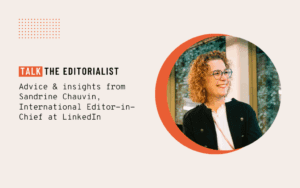Artificial intelligence is rapidly reshaping corporate content strategies—whether through blog articles, videos, LinkedIn posts, studies or white papers. Between task automation and large-scale personalisation, editorial and communication teams are reinventing the way they create.
But how can AI be integrated without losing what makes content truly valuable—expertise, originality, and the ability to connect with audiences? The organisations that stand out are those approaching AI with method and discernment, clearly defining where technology creates real added value and where human input remains irreplaceable.
Get in touch with an AI editorial expertIA New Paradigm for Editorial Production
The content landscape is undergoing a structural shift. B2B and B2C buyer journeys have become more complex, multiplying touchpoints between brands and audiences. Companies are diversifying their formats: long-form articles to build expertise, sectoral studies to inform strategic thinking, podcasts to humanise their message, and LinkedIn posts to sustain ongoing dialogue.
At the same time, algorithms are evolving. After SEO comes GEO (Generative Engine Optimisation)—a new discipline focused on optimising content for generative AI models that synthesise information directly for the end user.
This intensification in content demand brings both opportunities and risks. Content flooding—the mass production of generic material—dilutes brand messages and disengages audiences. The companies succeeding today are those that balance volume with value, and frequency with relevance.
Environmental impact is also becoming a strategic factor. A single ChatGPT query consumes roughly ten times more energy than a traditional Google search. This doesn’t mean AI should be avoided, but rather used consciously: optimising prompts, reusing generated material, and prioritising quality over quantity.
The real challenge is to build an efficient and responsible editorial machine. Leading organisations use AI as an accelerator while protecting human expertise in key phases: editorial positioning, fact-checking, and brand embodiment. This hybrid model increases output while also improving engagement metrics.
Designing an Augmented Content Factory
In the early stages, automated monitoring tools can identify trending topics, analyse target audiences’ questions, and map out potential communication territories. This preparatory analysis ensures that produced content genuinely resonates with readers.
Your technology stack shapes your editorial strategy. Generalist large language models such as ChatGPT or Claude.ai offer an accessible entry point but remain highly energy-intensive. Some companies go further, developing proprietary models—Bloomberg built BloombergGPT for finance, while consulting firms are designing specialised AI engines for strategy. Between these extremes, agile solutions are emerging: personalisation of existing models or Retrieval-Augmented Generation (RAG) systems combining LLMs with internal document databases. Each approach answers specific needs in terms of expertise, confidentiality and investment.
The production phase is now a collaboration between human and machine. AI excels at structure, topic framing and argumentation, while writers contribute field knowledge, sectoral insights and audience understanding. Together, they create content neither could produce alone.
Fact-checking, however, remains the exclusive domain of human intelligence. A NewsGuard study found that ChatGPT delivers factually incorrect information in about 40% of its answers. These “hallucinations” make it essential for editorial teams to reinforce verification and sourcing processes—this is how they earn legitimacy in today’s information ecosystem.
Writing Best Practices for AI-Assisted Production
Prompt engineering is central to content quality and energy efficiency. A precise, structured prompt reduces the need for multiple energy-intensive iterations. Instead of vague instructions requiring several reformulations, favour detailed briefings: sector context, clear objectives, technical constraints, tone examples.
An optimal workflow follows three key stages:
- Targeted generation — the AI produces a first draft from a single optimised prompt.
- Human enrichment — experts add case studies, client quotes, proprietary insights.
- Editorial validation — style harmonisation and fact verification, without reprocessing through AI.
High-quality sourcing becomes your competitive edge and protection against hallucinations. Feed your AI with premium reports, proprietary studies and verified notes—input quality directly determines output quality.
Poorly managed, AI adoption can quickly backfire. Stylistic homogenisation makes every article sound alike. Over-optimised SEO content becomes unreadable, buried under keyword overload. Excessive energy consumption follows when teams multiply prompts without strategy.
Define safeguards:
- Require every data point to be sourced with an explicit link.
- Run systematic similarity checks.
- Make human review mandatory.
- Set a limit on AI queries per project.
A sober approach favours intelligent reuse. A 20-page analysis report can be turned into a blog post, a LinkedIn motion, an infographic or a podcast script—but mainly through classic editorial adaptation rather than automated generation. This method lowers the carbon footprint while preserving editorial coherence.
Standing Out Through Voice and Expertise
In a sea of standardised content, the expert interview has become a safe haven. Authentic conversations—recorded once, then adapted across formats—bring what AI cannot replicate: lived experience, nuance, conviction.
In-depth case studies, documenting methodology and measurable results, provide long-term value far beyond ten superficial posts. Contradictory analyses, confronting multiple viewpoints in cross-interviews, signal a distinctive editorial maturity. Honest feedback, including failures and lessons learned, generates authenticity that no algorithm can mimic.
Editorial sobriety is becoming a differentiating stance. Choosing depth over speed—accepting longer publishing cycles for higher-impact outputs—appeals to audiences tired of generic content marketing, while also lowering environmental impact.
Building a unique editorial signature requires conscious choices that transcend AI. Some brands adopt a bold, provocative tone forged through years of field experience; others focus on pedagogy, powered by client cases or proprietary data analysis. This editorial personality, coherent over time, creates instant recognition that generative AI cannot threaten.
Towards responsible editorial production
The future of the augmented content factory lies in a measured and ethical approach. Leading companies are already establishing AI usage charters that define when to use automation (repetitive tasks, first drafts, format adaptation) and when to prioritise humans (original writing, expert analysis, sensitive content). They also measure the ratio of generated to original content—seeking a sustainable balance.
AI should be seen as a skills amplifier, not a substitute. Its use must be conscious, transparent and deliberate. The organisations that will thrive are those combining technological efficiency with energy sobriety, targeted automation with human creativity, performance with responsibility.
The future belongs to hybrid teams capable of orchestrating this human–machine collaboration while preserving the authenticity, expertise and impact that define strong editorial brands.
Book a meeting with our experts

